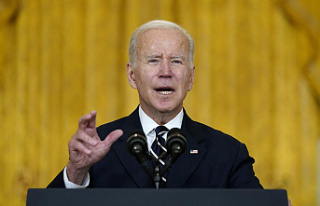The Western "Rust", which had a budget of $7 million, was not a micro-budget gem. It was less than the budget of "Nomadland", which was previously the Academy Awards' best-picture winner. Baldwin's New Mexico shoot had inexperienced crew members, safety lapses, and a labor dispute.
Some in the industry see the failures as a sign of larger problems in an ever-evolving film industry.
Mynette Louie, an independent producer of films, stated that production is on the rise, budgets are being reduced even more, and corners are being cut more. "Something has to give."
Filming took place at a busy moment: Production has been ramping up since the lifting of pandemic restrictions. Streaming services are gaining popularity. The industry is constantly trying to set standards for movie sets.
Adan Mendoza, Santa Fe County Sheriff, said that there was "some complacency” in the way weapons were handled. Investigators discovered 500 rounds of ammunition, which included blanks, dummy and suspected live rounds. This was despite Hannah Gutierrez Reed, the set's firearms specialist who claimed that real ammo shouldn't have been there.
The 24-year-old Gutierrez Reed was the focus of attention. He had only worked on one feature before and Dave Halls, the assistant director, handed the gun to Baldwin. According to a search warrant, Halls said that he called "cold gun" in order to indicate the weapon was safe to use. However, he told detectives that he didn't check all of its chambers.
Gutierrez Reed lawyers said Friday that Gutierrez Reed has no idea from where the live rounds originated. They blamed the producers for creating unsafe conditions.
Attorneys Jason Bowles, Robert Gorence and a statement said that Hannah was hired for two roles on the film. This made it very difficult to concentrate on her job as an armourer. "She fought for training and days to maintain weapons and the proper time to prepare to fire on gunfire, but she was ultimately overruled by her department and production. Due to a variety of factors, including a lack of safety meetings, the entire production set was made unsafe.
Neal W. Zoromski, a veteran prop master, previously told The Los Angeles Times he turned down an offer to work with "Rust" due to producers insisting that only one person could be both assistant prop master or armorer.
Veteran film workers are still stunned by the apparent lack proper weapons protocol.
"This was incompetence and inexperience, and -- I hate this to say -- lack of care about your job. Mike Tristano, a veteran professional armorer, said that if a lot of ammunition is thrown in a box, it's not the way it's done.
Many members of the "Rust" camera crew walked off set amid disagreements over working conditions and safety procedures. According to Joel Souza (director), a new crew was hired. He spoke with detectives. The shot hit him as he stood near Hutchins.
The New Mexico chapter of International Alliance of Theatrical Stage Workers union called reports of nonunion employees being brought in "inexcusable." The union will vote soon on a new standards agreement that covers 60,000 film and television crew members. This deal was reached with major studios following preparations by IATSE for its first strike in 128 years.
Allen Cheney, executive producer of "Rust", stated that the six film producers had a combined experience of more than 35 years in television and film. He described "Rust as a union-certified production."
James Gunn, the filmmaker of "Guardians of the Galaxy", suggested that a slipshod culture might be partially to blame.
Gunn stated on Twitter that "Dozens of people have died or been seriously injured on movie sets due to irresponsibility and ignoring safety protocols. Improper leadership and a culture of mindless hurrying."
Serge Svetnoy was the film's gaffer. He criticized the producers for their "negligence."
Svetnoy stated in a Facebook post that "to save a dime sometimes you hire people who don't fully qualify for the complex and dangerous job."
Gary Tuers, the property master of "Tomorrow War", and "Jurassic World: Fallen Kingdom," stated that the shooting was an indictment against modern production culture. They have pursued tax credits for 30 years and found many ways (and some that weren't) of sacrificing crew safety and health in order to meet budget constraints.
He wrote that the tragedy was "an apparent accident" on Instagram. "But it was also predictable because of the incentive structure in the modern film industry."
Many companies joined forces to finance and produce "Rust," which included Baldwin's El Dorado Pictures. Based on a story by Souza, Baldwin, the film was partially funded by Streamline Global in Las Vegas. It describes its business model as "acquiring movies that offer certain tax advantages" that could "reduce the owner’s federal income tax liability."
BondIt Media Capital is an independent film financier that also funded "Rust." This Santa Monica-based company also helped finance other male-fronted action thrillers such as "Honest Thief", Mel Gibson's" Force of Nature, and Bruce Willis’ "Hard Kill."
Before the shooting began, "Rust", the most likely destination was video on demand. Some distribution rights were presold by Baldwin's agency Creative Artists Agency. Baldwin promoted the film to buyers at the virtual Cannes movie market last year. According to The Hollywood Reporter, Baldwin said that the script reminded of "Unforgiven," a 1992 Western starring Clint Eastwood.
Section 181, a tax provision that applies to films between $2.75 million and $7.5 million, was used to make the movie. This can help investors break even before the film is released, especially in states with generous tax credits such as New Mexico. In recent years, the state has become a very popular location for productions. It has some regulations that are more stringent than California's, such as for experts in on-set weapons.
Tristano, an armorer, hasn't had to deal with crew members or producers who have cut corners on safety in his 30 year career. When safety is at stake, Tristano has never hesitated to pull his crew off a set.
Tristano stated, "Whenever there was panic on the set or the assistant director was hurrying, I would say, "OK, I'm locking my guns back in the truck." "I would say, "When you guys are ready and willing to do it right, then we'll do that." I'm open to suggestions, but you can't please me.












